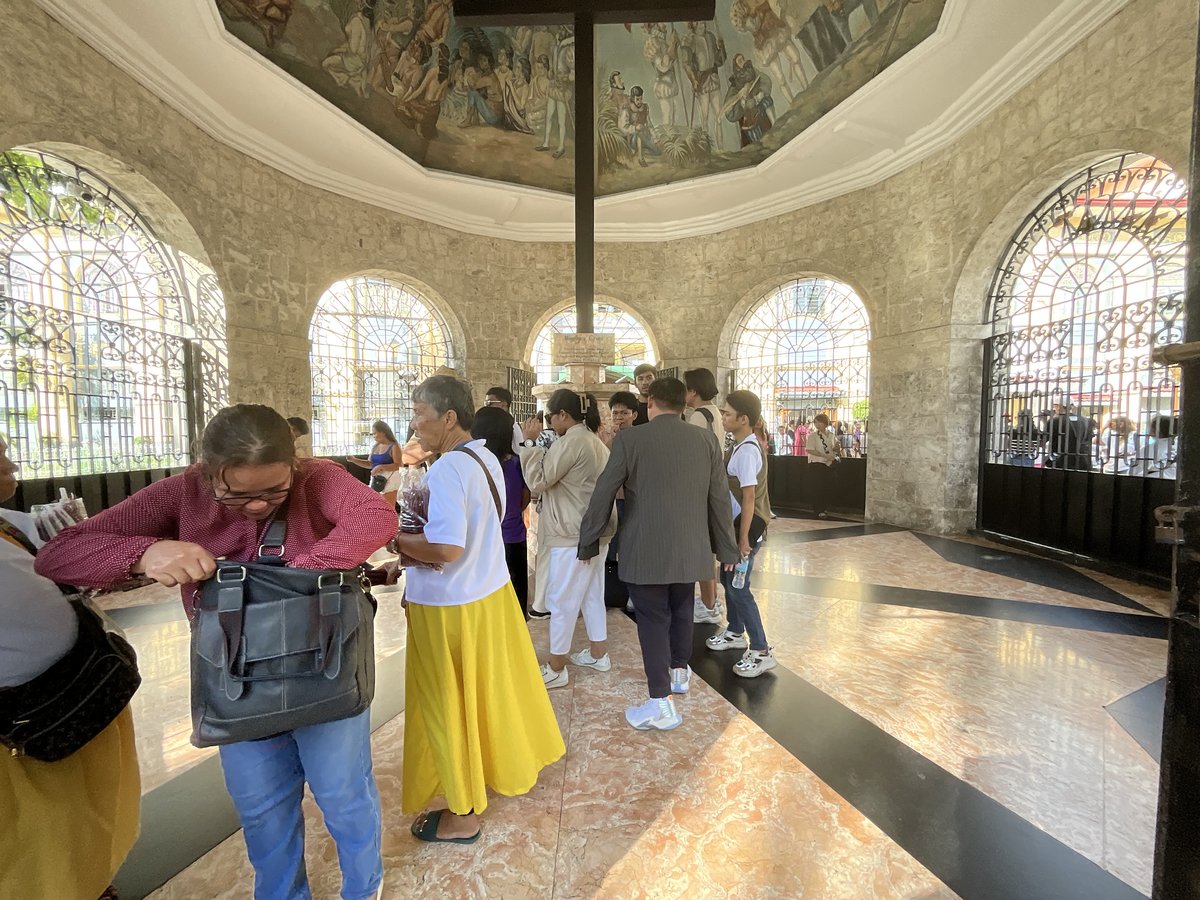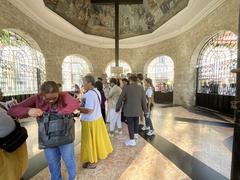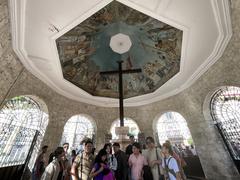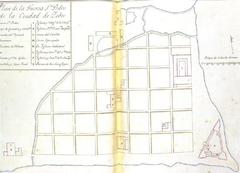
Visiting Magellan’s Cross: Tickets, Hours, and History
Publication Date: 17/07/2024
Introduction to Magellan’s Cross
Magellan’s Cross in Talisay, Cebu, Philippines, stands as a monumental testament to the nation’s rich historical tapestry and religious heritage. Erected by the Portuguese explorer Ferdinand Magellan on April 21, 1521, the cross marks a pivotal moment in Philippine history—the introduction of Christianity to the archipelago. This event not only set the stage for over three centuries of Spanish colonization but also brought about profound cultural and societal transformations. The cross, encased within a protective structure to prevent damage, is located near the Basilica Minore del Santo Niño, making it a focal point for both historical education and religious pilgrimage (National Historical Commission of the Philippines) (Cebu City Government). Whether you are a history enthusiast, a religious devotee, or a curious traveler, visiting Magellan’s Cross offers a unique opportunity to delve into the complex and multifaceted history of the Philippines. This guide aims to provide comprehensive insights into the cross’s historical significance, visitor information, travel tips, and nearby attractions to ensure a fulfilling and respectful visit.
Contents Overview
- Introduction
- Historical Background
- Early Beginnings and Erecting the Cross
- The Role of Rajah Humabon
- The Original Cross and Its Preservation
- Spanish Colonial Influence
- The Battle of Mactan
- Restoration and Conservation Efforts
- Visitor Information
- Ticket Prices and Visiting Hours
- Travel Tips
- Nearby Attractions
- Cultural and Religious Significance
- Educational and Tourism Impact
- Preservation Challenges
- FAQs
- Conclusion
Historical Background
Early Beginnings and Erecting the Cross
Magellan’s Cross, located in Talisay, Philippines, is a significant historical landmark that dates back to the early 16th century. The cross was erected by Portuguese explorer Ferdinand Magellan on April 21, 1521, upon his arrival in Cebu. This event marked the beginning of Spanish colonization in the Philippines and symbolized the introduction of Christianity to the archipelago, a pivotal moment in Philippine history (National Historical Commission of the Philippines).
The Role of Rajah Humabon
Rajah Humabon, the local chieftain of Cebu, played a crucial role in the historical significance of Magellan’s Cross. After Magellan’s arrival, Humabon, along with his wife and hundreds of his followers, were baptized into Christianity. This mass conversion was a strategic alliance, as it strengthened Magellan’s position and influence in the region. The cross was planted to commemorate this significant event, symbolizing the spread of Christianity in the Philippines (Philippine History).
The Original Cross and Its Preservation
The original cross planted by Magellan is believed to be encased within the current cross housed in a small chapel, known as a “kiosk,” located near the Basilica Minore del Santo Niño in Cebu City. This encasement was done to protect the original cross from damage and to prevent devotees from chipping away pieces of it as souvenirs or for its believed miraculous powers. The kiosk itself is an octagonal structure built in 1834, showcasing Spanish colonial architecture (Cebu City Government).
Spanish Colonial Influence
The erection of Magellan’s Cross marked the beginning of over three centuries of Spanish colonial rule in the Philippines. The cross not only symbolizes the spread of Christianity but also the start of significant cultural and societal changes brought about by Spanish colonization. The Spanish influence is evident in various aspects of Filipino culture, including religion, language, and architecture. The cross stands as a testament to these historical transformations (National Commission for Culture and the Arts).
The Battle of Mactan
The historical narrative of Magellan’s Cross is incomplete without mentioning the Battle of Mactan. On April 27, 1521, just days after the erection of the cross, Magellan was killed in a skirmish with local warriors led by Lapu-Lapu, a chieftain of Mactan Island. This battle is significant as it represents the resistance of the native Filipinos against foreign invaders. Despite Magellan’s death, the cross remained a symbol of the enduring influence of Spanish colonization and Christianity in the region (Philippine History).
Restoration and Conservation Efforts
Over the centuries, Magellan’s Cross has undergone several restoration and conservation efforts to preserve its historical and cultural significance. The most recent restoration was carried out in the early 2000s, focusing on the structural integrity of the kiosk and the cross itself. These efforts are crucial in maintaining the site as a historical landmark and a place of pilgrimage for both locals and tourists (Cebu City Government).
Visitor Information
Ticket Prices and Visiting Hours
Magellan’s Cross is open to the public daily, typically from 8:00 AM to 6:00 PM. There is no entrance fee, making it accessible to everyone. However, donations are welcome to help with the site’s maintenance and preservation.
Travel Tips
- Best Time to Visit: Early mornings or late afternoons are ideal to avoid the heat and crowds. The site can get quite busy, especially during religious festivals.
- Dress Code: As it is a religious site, modest attire is recommended. Avoid wearing shorts or sleeveless tops.
- Guided Tours: Consider joining a guided tour to gain deeper insights into the historical significance of Magellan’s Cross and its surrounding areas.
- Photography: The cross and the kiosk are popular spots for photography. Be respectful of other visitors and avoid using flash inside the chapel.
Nearby Attractions
- Basilica Minore del Santo Niño: Just a short walk from Magellan’s Cross, this basilica is another significant historical and religious site in Cebu.
- Fort San Pedro: Located nearby, this is a military defense structure built by Spanish and indigenous Cebuano laborers under the command of Spanish conquistador, Miguel López de Legazpi.
- Cebu Heritage Monument: A tableau of sculptures depicting scenes about the history of Cebu, from the time of Rajah Humabon to the recent beatification of Cebuano martyr Pedro Calungsod.
Cultural and Religious Significance
Magellan’s Cross holds immense cultural and religious significance for Filipinos. It is not only a historical marker but also a symbol of faith and resilience. The cross is a focal point during religious celebrations, particularly during the annual Sinulog Festival, which honors the Santo Niño (Holy Child) and commemorates the arrival of Christianity in the Philippines. The festival attracts millions of devotees and tourists, highlighting the enduring legacy of Magellan’s Cross (Sinulog Foundation).
Educational and Tourism Impact
Magellan’s Cross is a major tourist attraction and an educational site. It provides visitors with a glimpse into the rich history and cultural heritage of the Philippines. The site is often included in historical tours of Cebu, offering insights into the early interactions between Filipinos and Europeans. Educational programs and guided tours help in disseminating knowledge about the historical significance of the cross, making it an essential part of the cultural landscape of Cebu (Department of Tourism).
Preservation Challenges
Despite its historical importance, Magellan’s Cross faces several preservation challenges. Environmental factors, such as humidity and pollution, pose threats to the structural integrity of the cross and the kiosk. Additionally, the high foot traffic from tourists and devotees can lead to wear and tear. Continuous efforts are required to address these challenges and ensure the preservation of this historical landmark for future generations (National Historical Commission of the Philippines).
FAQs
- Is there an entrance fee to visit Magellan’s Cross? No, there is no entrance fee, but donations are appreciated.
- What are the visiting hours for Magellan’s Cross? The site is typically open from 8:00 AM to 6:00 PM daily.
- Are guided tours available? Yes, guided tours are available and recommended for a more comprehensive understanding of the site’s history.
- Is photography allowed? Yes, photography is allowed, but please be respectful of other visitors and avoid using flash inside the chapel.
- What nearby attractions can I visit? Nearby attractions include the Basilica Minore del Santo Niño, Fort San Pedro, and the Cebu Heritage Monument.
Conclusion
Magellan’s Cross stands as a powerful symbol of the Philippines’ rich history and cultural heritage. Its erection marked the beginning of significant historical events, including the spread of Christianity and the onset of Spanish colonization. The cross continues to be a site of religious devotion, cultural celebration, and historical education, reflecting the enduring legacy of Ferdinand Magellan’s voyage and the profound impact it had on the Philippines (Cebu City Government).
Call to Action
Plan your visit to Magellan’s Cross and explore the rich history of Cebu. For more information on travel tips, guided tours, and nearby attractions, follow us on social media and check out our other related posts.



